According to the latest data, there were 5,190 work-related fatalities in 2021 in the US, while around 2.6 million people suffered from non-fatal workplace injuries.
Without safety meetings, our workplaces would be even less secure, and the places where we spend most of our workdays might even become quite dangerous.
To eradicate work-related fatalities and injuries, you need to be familiar with various safety topics. That’s why we created this article that will help you:
- Understand the concept of safety meetings in the workplace,
- Get familiar with different types of safety talks at work,
- Organize safety meetings, and
- Make safety meetings fun.
Without further ado, let’s dive into it!

- Safety meeting topics help raise awareness about the most common workplace injuries and help employees avoid them.
- The nature of safety meeting topics depends on the industry.
- Every company should comply with 5 key topics of OSHA — prevention, compliance with laws and regulations, employee engagement, influential leadership, and social responsibilities.
- Conduct proper research and make every safety meeting engaging and useful — if you don’t do so, they can be counterproductive.
- Safety meetings don’t have to be boring. Include interactive activities or invite guest speakers to make them more interesting.
Table of Contents
What are safety topics at the workplace?
Safety topics at the workplace help raise professionals’ awareness of various risks they might face and teach them how to mitigate accidents.
In other words — safety topics are the foundation of every safety meeting.
President of Mammoth Security, Eugene Klimaszewski, adds that safety meetings focus on topics regarding preventing danger:

“Safety topics and discussions revolve around:
- Averting mishaps,
- Upholding overall health, and
- Fostering vigilance concerning potential workplace dangers.”
In most cases, you will go through safety topics during:
- The onboarding process,
- Regular safety meetings,
- The aftermath of a violation of safety regulations, and
- Toolbox talks.
However, the nature of safety topics depends on the situation and the company’s praxis.
12 safety topics to talk about at the workplace
The nature of safety meeting topics depends on your job.
For example, it is unlikely that you’ll discuss the same safety topics if you work in the mining industry as you would if you worked in digital marketing.
Themes can vary — from discussing mental health in the workplace to deliberating what kind of safety equipment you need to use.
However, you never know when some safety topics you covered might come in handy.
One of our contributors, Lou Reverchuk, who as a Co-Founder and CEO of EchoGlobal has the huge responsibility of making the workplace safe for all of his employees, shared his list of most prevalent safety subjects:

“Common safety topics include:
- Ergonomic practices,
- Emergency evacuation procedures,
- The use of personal protective equipment,
- Chemical handling,
- Electrical safety and fire prevention,
- Mental health, and
- Workplace violence prevention.”
Since we know that going through all these courses might be tiring, we have prepared an analysis of the most common safety topics.
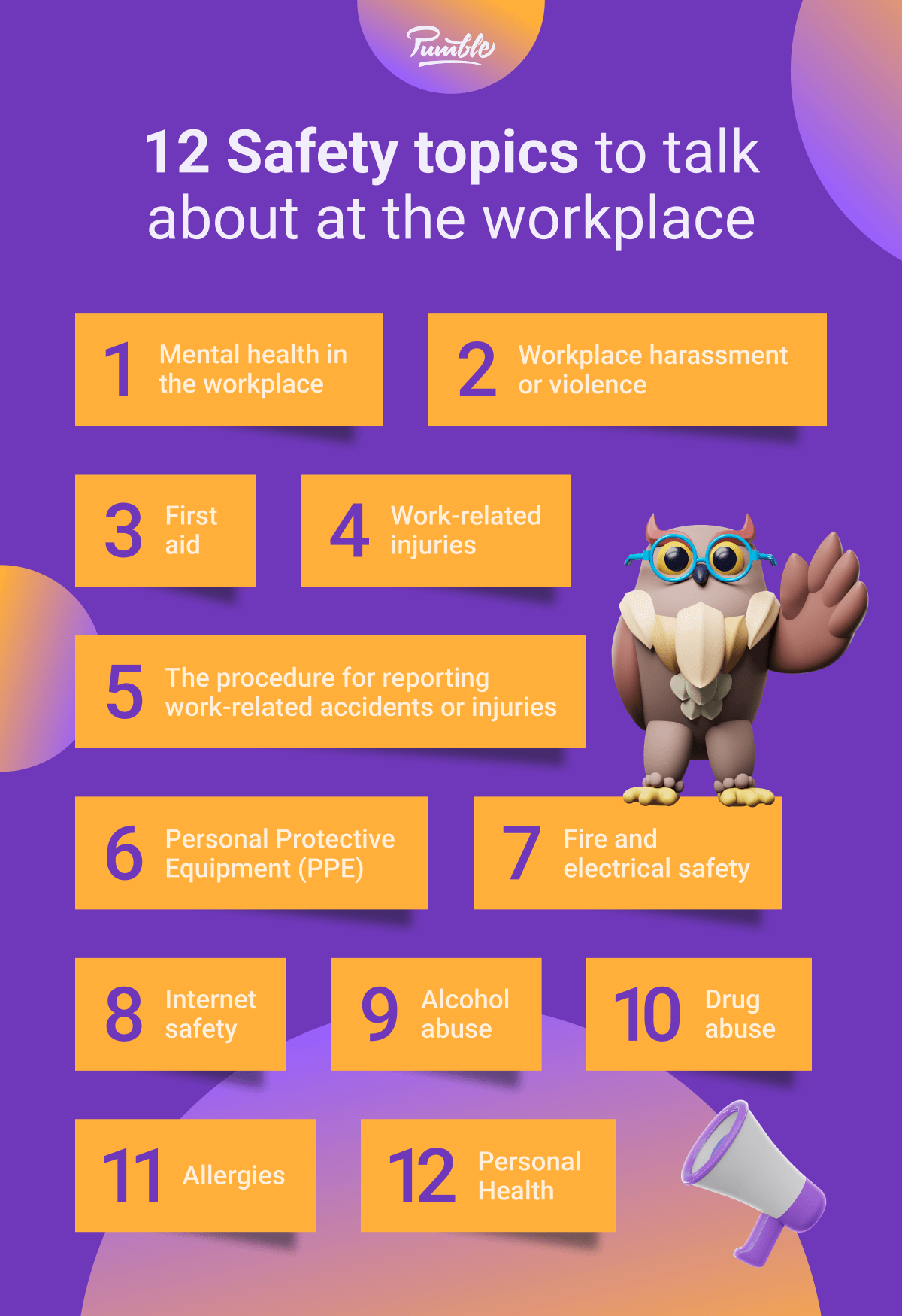
Topic #1: Mental health in the workplace
No matter which industry you work in, in order to be productive and perform well, you need to feel safe in your workplace and try to preserve your mental health.
Companies should always foster a positive work environment and healthy work relations between professionals to make employees feel good about coming to work.
Still, it is not enough for company leaders to say, “Hey, we want you guys to be positive and cooperate well with your colleagues!”.
On the contrary, they must show they care about their employees’ well-being.
The safety meeting regarding mental health in the workplace should:
- Prioritize healthy work-life boundaries,
- Raise awareness about the importance of the mental health of each member of the team,
- Notify employees about the company’s mental health programs and workshops in which employees can enroll if they need to,
- Help employees connect better — for example, by organizing team-building activities, and
- Inform employees about covering the expenses of mental health counseling or emergencies.
As you see, workplace safety meetings about mental health demand careful organization and good collaboration.
💡 Pumble Pro Tip
To learn more about mental health in the workplace and how to preserve it, check out the following article:
Topic #2: Workplace harassment or violence
There is no room for harassment and violence in the workplace.
So, holding safety meetings about making a psychologically safe environment is paramount.
During those meetings, managers or safety officers should:
- Encourage employees to share their work-related ideas and opinions,
- Foster critical thinking,
- Introduce employees to the idea of diversity, equity, and inclusion in the workplace,
- Warn employees about unconscious biases,
- Forbid any kind of derogatory or malicious comments, and
- Introduce zero-tolerance violence or harassment policy.
By attending safety meetings that promote the aforementioned ideas, employees become more open-minded and tolerant.
As a result, the chances of any harassment or violence in the workplace go down.
💡 Pumble Pro Tip
During the safety meetings, you can also tackle the topics of gaslighting at work.
To learn more about it and why it is harmful to the workplace atmosphere, check out the following article:
Topic #3: First aid
Safety meetings where employees learn how to provide first aid should be common in every company.
In some cases, every minute matters. Being able to notice that someone has a heart attack or stroke, knowing how to do CPR (cardiopulmonary resuscitation), or stop bleeding can save people’s lives.
So, companies should create first aid courses and bring a medic or a doctor in to explain everything about providing emergency treatment in detail.
Companies should also schedule occasional toolbox talks to remind employees where to find first aid kits if needed.
Topic #4: Work-related injuries
One of the most useful toolbox talk ideas is to make your employees aware of the most common work-related injuries.
Therefore, company managers or security officers should:
- Conduct research and find out the most frequent type of injuries for employees in their industry, and
- Make a presentation that will warn employees to be extra careful when performing risky duties.
Combining this toolbox talk and first-aid courses might prevent work-related injuries and save lives, especially if you work in industries with higher injury risks.
Topic #5: The procedure of reporting work-related accidents or injuries
Unfortunately, even if we do everything right, injuries can still happen.
Therefore, employees should know what procedure to follow after one occurs.
If employees have gone through safety meeting topics about first aid and work-related injuries, they should know how to provide emergency assistance.
However, they should also learn what to do afterwards and whom to call to report an injury.
So, doing occasional 10-minute safety meetings where you describe the procedure everyone needs to follow after an injury happens will prove useful.
Topic #6: Personal Protective Equipment (PPE)
Teaching employees how to use their PPE properly is one of the essential industrial safety topics.
Even employees who have been with the company for a while should occasionally be reminded about the proper use of PPE and its benefits. During the safety meetings, managers or safety officers should also highlight how the equipment employees use can save their lives.
On the other hand, special attention should be paid to new employees who still have to learn how to use PPE accurately.
To help new employees understand the importance of using PPE, companies should:
- Create courses,
- Go through industrial safety topics, and
- Assign senior employees as mentors.
If you are wondering whether investments in PPE and accompanying training are too expensive, just bear in mind the following — an investment of $9.6 billion in PPE for all healthcare workers worldwide, yields a collective, societal return on investment of $755.2 billion.
Topic #7: Fire and electrical safety
One of the most common general safety topics for all industries is fire and electrical safety.
According to Fred Winchar, who, as a Co-Founder and President of MaxCash, faced a serious security incident a few years ago, planning emergency actions is of utmost importance:

“Without offering guidance and information on what people should do in an emergency event, they will likely panic. So, discussing emergency action planning with employees — what numbers to call and what they should do — is paramount.”
Proper meetings about fire and electrical safety should include:
- Information on fire extinguishers’ location and use,
- Information on alarms at the workplace, and
- Evacuation drills.
Furthermore, regular fire drills with firefighters’ representatives present should take place in the workplace.
After completing fire and electrical safety training, employees will know how to react in case of a fire.
Topic #8: Internet safety
Hackers are blackmailing multinational companies!
Cyber attackers use malware to demand ransom from rich IT companies!
Cyber-terrorists hacked the elections!?
All these headlines have become a part of our reality. Hence, companies must be extremely cautious regarding internet safety, especially if their income comes from IT services or online activities.
To avoid cyber attacks, companies should hold frequent safety meetings to discuss internet safety.
During these meetings, IT Security Officers should:
- Explain to employees what to do with suspicious emails,
- Raise awareness of phishing attacks, and
- Draw attention to what employees should not do online while using company gear.
Furthermore, these toolbox meetings should also cover recent trends and events in cybersecurity, especially if the company has suffered a loss due to internet fraud and cyberattacks.
Topic #9: Alcohol use
Highlighting the side effects of alcohol use should be one of the safety talk points for managers and safety officers — especially if they work in industries with a higher risk of physical injuries.
According to the latest research about alcohol consumption conducted by the National Institute on Alcohol Abuse and Alcoholism, 78.3% of people ages 12 and older in the US have tried alcohol at some point.
Hence, it is almost impossible to forbid your employees from consuming alcohol in their spare time.
However, you should point out the consequences of excessive drinking and make your employees aware that frequent drinking outside of work can seriously affect their work performance.
Excessive use of alcohol can cause:
- Memory problems and dementia,
- Frequent hangovers affecting motor skills,
- Mental health issues such as depression and anxiety,
- High blood pressure and heart problems, and
- Various types of cancers.
Keep in mind that discussing alcohol use will most likely be one of the more challenging safety topics, since professionals often perceive having a few pints or shots of hard liquor every few days as harmless.
Topic #10: Drug abuse
Illicit drug use has dire consequences in both the personal and professional lives of employees.
Some of the drug abuse effects employees should be familiar with are:
- Tardiness,
- Lack of focus,
- Poor decision-making and time management,
- Weaker professional performance, and
- Theft.
Although we might think that everyone is aware that drug abuse will affect their performance (and, therefore, that they should avoid it), studies have shown that 1 out of 11 professionals in the US have struggled with alcohol or substance abuse in the past 12 months.
According to research, professionals in the following fields have more frequent problems with drug and alcohol abuse:
- Construction,
- Service,
- Sales, and
- Maintenance.
Hence, managers and officers in those sectors should schedule frequent safety meetings to discuss the consequences of drug abuse.
Topic #11: Allergies
One of the most unique safety topics is allergies.
These toolbox talks should be organized if a company:
- Provides free meals,
- Works with animals, or
- Works outside.
During these quick, 1-on-1 meetings with managers, employees should notify their superiors about any allergies or intolerances.
Also, if you have any drug allergies, you should inform your manager, especially if there are some company-funded trips planned for the future.
Topic #12: Personal health
Calling safety meetings where you insist on regular health check-ups of your employees is beneficial in many ways.
First, your employees will appreciate that their company cares about their health.
Second, showing that you care about your employees will increase employee engagement.
Finally, regular check-ups can be preventative, which will result in healthier individuals and a fewer number of sick leaves.
Also, don’t forget to use these safety meetings as an opportunity to ask your employees for feedback and suggestions on how the company can further improve its healthcare policies and benefits.
💡 Pumble Pro Tip
If some of your colleagues or employees have taken sick leave, a simple get-well-soon message will show that you care about them.
To learn more about those messages, check out our article:
What are the 5 key topics of OSHA
OSHA is the US Department of Labour’s regulatory agency whose mission is to assure safe working conditions for everyone.
Hence, OSHA has established many principles for various industries.
5 key topics of OSHA are:
- Prevention,
- Compliance with laws and regulations,
- Employee engagement,
- Influential leadership, and
- Enhancement of social responsibilities.
Regardless of the industry you work in, familiarizing yourself with the following 5 key topics of OSHA will contribute to your employees’ safety.
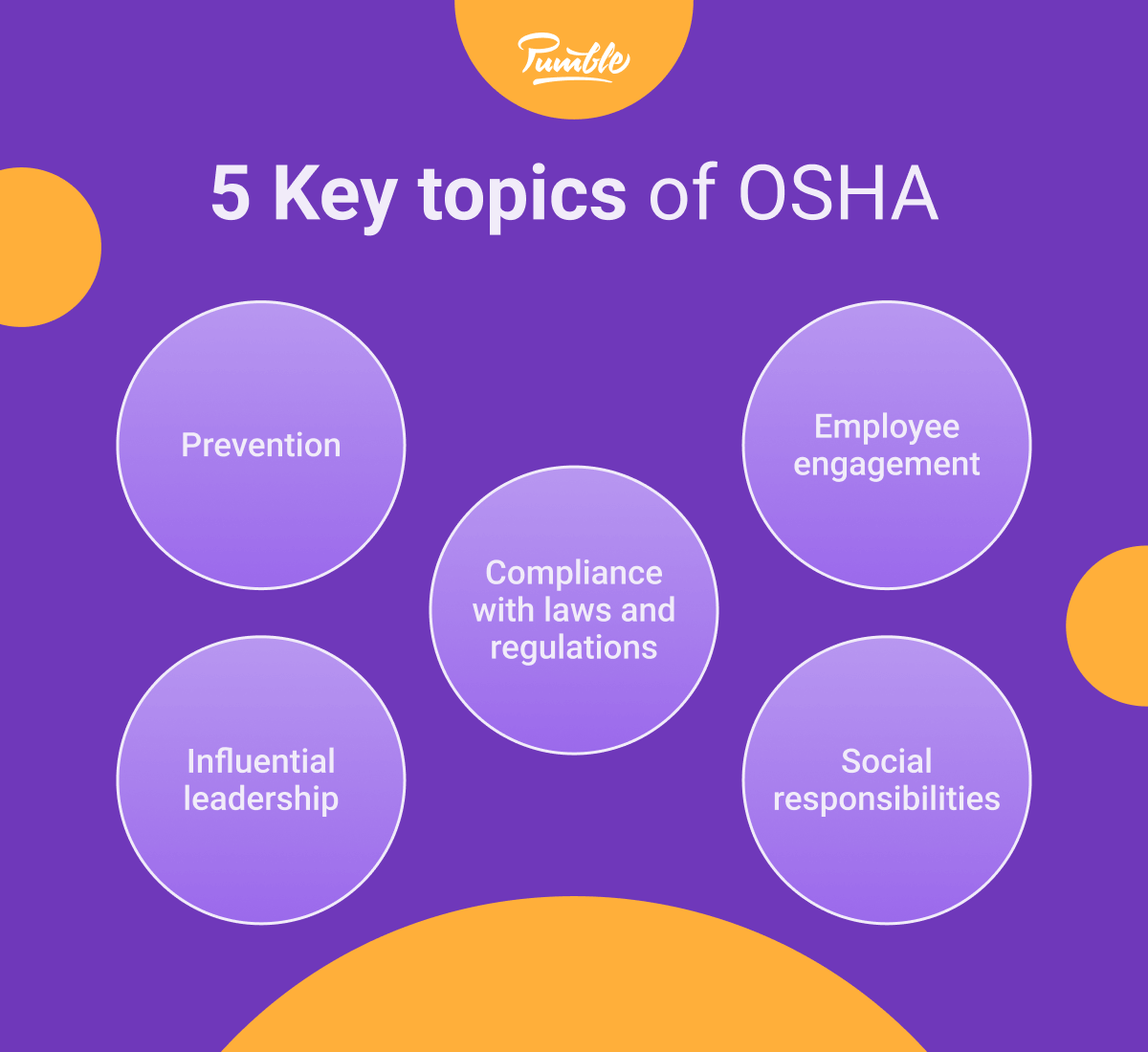
OSHA Topic #1: Prevention
Investing time and funds in prevention is more effective and cost-efficient than looking for cures and solutions once a problem appears.
OSHA warns that many companies have an approach that tends to resolve problems once they appear instead of stopping them from occurring.
That approach might benefit companies in the short term. However, the only way to ensure the long-term happiness and productivity of your employees is to discuss the aforementioned safety meeting topics on time and take steps to prevent any incidents.
OSHA Topic #2: Compliance with laws and regulations
Complying with all Safety at Work laws and regulations is a must for every company.
Those laws shouldn’t be just dead letters on paper.
They are the result of many past accidents, put in place to prevent any kind of similar accidents from happening again.
So, educate your managers, safety officers, and employees about the laws and regulations — that way you will have trained personnel able to spot a problem or potential danger in the workplace.
Also, make sure to schedule frequent toolbox talks to check if everything is in accordance with the law — that will make everyone’s life easier.
OSHA Topic #3: Employee engagement
Theory can often be boring, and, let’s face it — many professionals go to safety meetings because they have to, not because they are willing to learn.
Therefore, to make sure their audience actively listens and learns, companies should make safety meetings engaging.
That can be done by:
- Making meetings fun,
- Including employees in problem-solving,
- Bringing professionals, such as doctors and firefighters, to demonstrate what to do during particular crises, and
- Creating attractive presentations and signs at the workplace.
💡 Pumble Pro Tip
Did you know that particular colors have a greater effect on human behavior than others?
That’s why they are used for danger or traffic signs.
To learn more about how colors can help you raise awareness and improve employees’ engagement regarding safety, check out the following article:
OSHA Topic #4: Influential leadership
Managers play a vital role in a company’s development and success.
Therefore, a good manager should be a role model to colleagues and employees.
When it comes to safety at work, they must lead by example and know every safety regulation and procedure.
While discussing workplace health and safety topics, managers should:
- Check if everyone understands what they should do in case of emergency,
- Provide additional explanations if needed,
- Praise employees who comply with safety rules, and
- Criticize or enforce repercussions if someone ignores the safety regulations.
Managers are often first in the chain of command, so their leadership can make a difference between the success and failure of complying with OSHA regulations.
OSHA Topic #5: Social responsibilities
Although social responsibility is not directly related to safety at the workplace, it most certainly contributes to the overall well-being of employees.
For example, if a company is in a polluting industry, discussing how it can preserve the environment (for example, by investing in filters) would show everyone it cares about the environment and, by extension, society.
Companies should also take a stance regarding social issues and raise awareness about tolerance and inclusion by organizing panel discussions where employees can share their opinions.
Types of safety talks at work
The type of safety talks at work depends on the:
- Topic,
- Available time, and
- Professionals’ familiarity with the topic.
Bearing in mind the aforementioned factors, the most common types of safety talks at work are
- Short safety talks,
- Health and safety talks,
- General safety talks, and
- Toolbox talks.
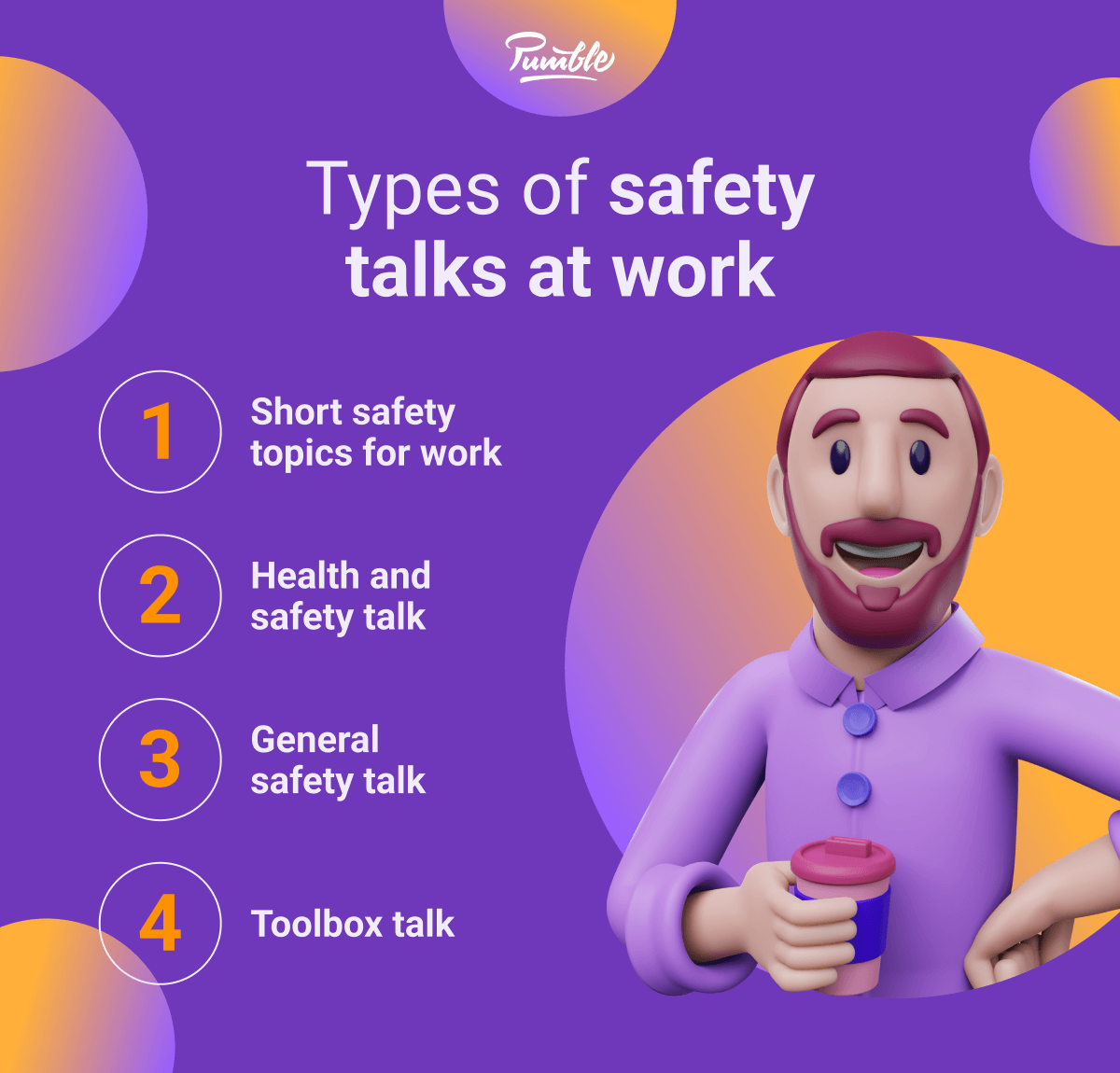
Type #1: Short safety topics for work
Keeping everything short and sweet might have a long-term positive impact on employees.
Therefore, managers and safety officers often pick short safety topics for work and discuss them together with employees.
Short safety topics usually introduce employees to new simple safety rules and warn them to obey the old regulations.
They shouldn’t be longer than 20 minutes.
💡 Pumble Pro Tip
Being an effective communicator might help you a lot during short meetings.
To learn what makes an effective communicator, check out the following article:
Type #2: Health and safety talk
Explaining to colleagues and employees how safety in the workplace can contribute to their health and well-being should be one of the companies’ top priorities.
Therefore, health and safety talks should be scheduled often, and their importance should not be neglected.
Type #3: General safety talk
Employees can discuss various topics during general safety talks.
Some of the most common topics for the general safety talks are:
- New safety laws and regulations,
- Recent security breaches, and
- Ways to further improve safety in the workplace.
Also, managers and security officers should make time for their employees to ask safety-related questions during this meeting.
Type #4: Toolbox talks
Toolbox talks are short, 5 to 10-minute long talks.
Companies hold them when some safety tips need to be shared for an upcoming assignment or task.
Toolbox talks are a great way to increase the trust between employees and managers since they are intended for individuals or small groups of workers.
How do you make a safety meeting useful?
Empty rhetoric is the biggest adversary of useful safety meetings.
To help you avoid sounding insincere and boring, we have prepared a few tips to make your safety meetings useful.
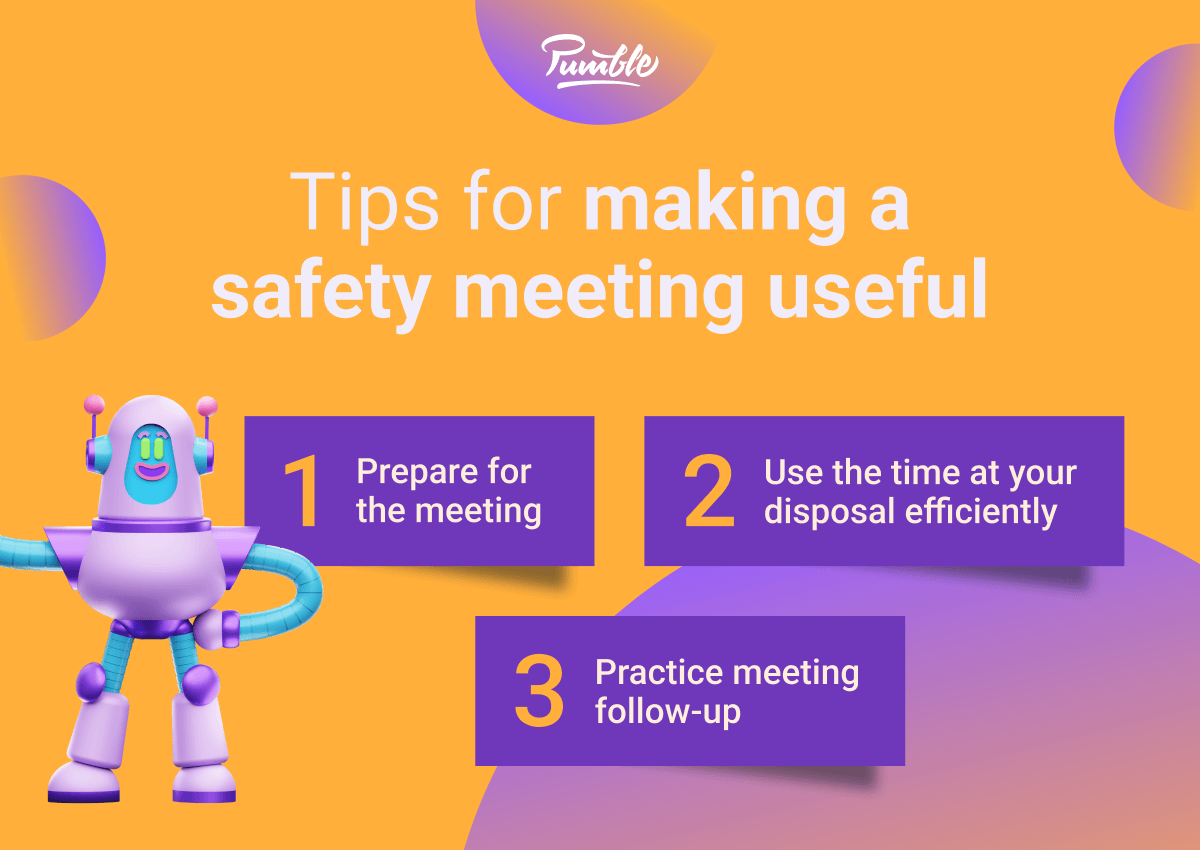
Tip #1: Prepare for the meeting
According to Winchar, preparing for the safety meeting is one of the most important things to do:

”First and foremost, I ensure I have prepared adequately for the safety meeting.
The proper preparation includes:
- Coming up with an interesting safety topic,
- Creating visuals,
- Alerting employees about the safety meeting and the topics we will discuss, and
- Scheduling a reminder before the meeting.
Most importantly, I always address one safety issue at a time to ensure the meeting is useful and successful.”
Reverchuk has a similar routine for preparing safety meetings:

“I try to make safety meetings useful by:
- Including topics that are relevant to current workplace challenges,
- Creating engaging and interactive sessions,
- Providing clear action points, and
- Regularly reviewing and updating the content.”
Our contributors confirm you can make safety meetings useful by doing proper research and seriously investing some time in the safety meeting topics.
Tip #2: Use the time at your disposal efficiently
Since longer meetings can be tiring, you might lose your employees’ attention at some point.
Therefore, it is up to you to make these meetings concise and engaging.
Winchar recommends safety meetings last no longer than 30 minutes:

”I recommend spending a maximum of 30 minutes addressing the safety topic, as this is the attention span most employees have, considering they have had other tasks to do or they are simply winding up their day.”
He also highlights that taking an interactive approach keeps employees interested in what you have to say:

”I make the meetings interactive and engaging by asking employees questions and involving them in necessary demonstrations, e.g., first aid training. Our colleagues and employees shouldn’t be observers only, but participants, as well.”
Klimaszewski adds that the theory you talk about must be supported by real-life examples:

”The key to useful safety meetings is relevance. Tailor the safety meetings’ topics to real-world scenarios your team faces and address the most common workplace incidents.”
Tip #3: Practice meeting follow-ups
Checking if your colleagues and employees have understood everything that was discussed during the meeting is crucial for making a workplace safe.
Winchar confirms that practicing meeting follow-ups can reinforce the message:

“I consider following-up important because it:
- Reinforces the message,
- Measures the effectiveness of the meeting, and
- Gives me insights on what safety topic to discuss in future meetings.”
You can follow-up in person at the end of the meeting, or by sending employees a follow-up email.
However, Klimaszewski believes that open dialogue might produce better results:

“Encourage open dialogues, where members can share experiences and, most importantly, learn from each other.”
If you opt for a follow-up email, it would be good to include a short summary of the discussion, so that the employees could have everything they need at their fingertips.
How do you make a safety meeting fun?
Although safety topics for work meetings are no laughing matter, the meetings don’t have to be boring.
On the contrary, they should be interactive and include role-play supported by guest speakers.
Reverchuk recommends including various activities to make a safety meeting fun:

Make safety meetings more fun and interesting by:
- Using multimedia presentations,
- Describing real-life stories or case studies,
- Including interactive games or simulations,
- Inviting guest speakers, and
- Fostering group discussions or role-playing exercises.
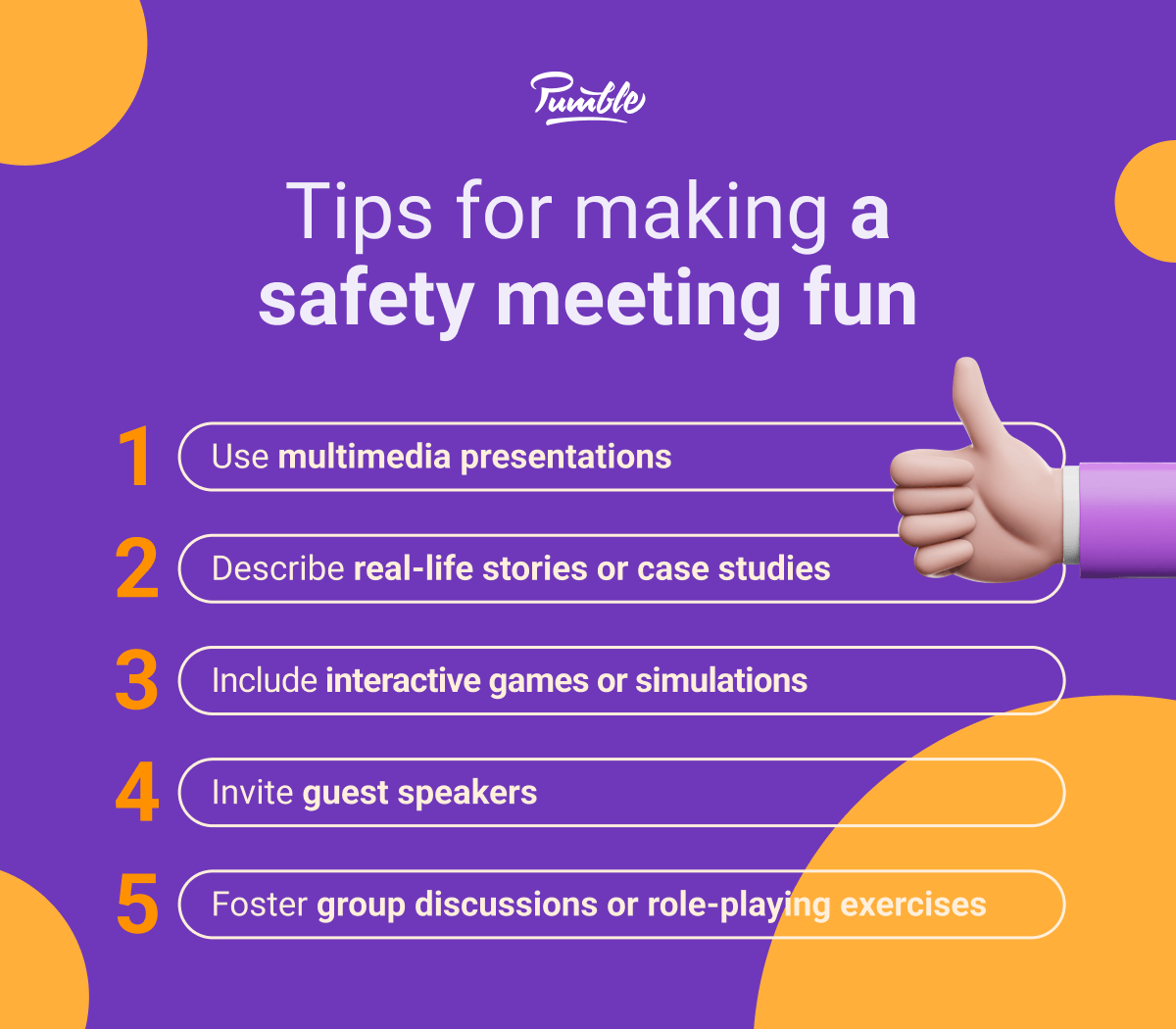
Make safety meetings productive and engaging with Pumble
Before we actually need any of the information that we can acquire at safety meetings, it’s perfectly natural to find them redundant or maybe even dull. That’s why you should try everything you can to make them more engaging and productive.
Pumble can help with that!
A team communication and collaboration app, Pumble offers a myriad of features that will help you engage your employees and make those dreaded safety meetings a bit more upbeat:
- Video conferencing, that allows you to include your entire team in the safety meeting,
- A Google Calendar plug-in, that allows you to create, manage, and share safety meetings straight from your calendar,
- Screen-sharing, that will help you effortlessly present vital safety information, and
- In-call messaging, that will allow your team members to stay engaged and participate during the meeting.
If you like what you’ve read, and think Pumble can help you conduct the best possible safety meetings, don’t hesitate!




